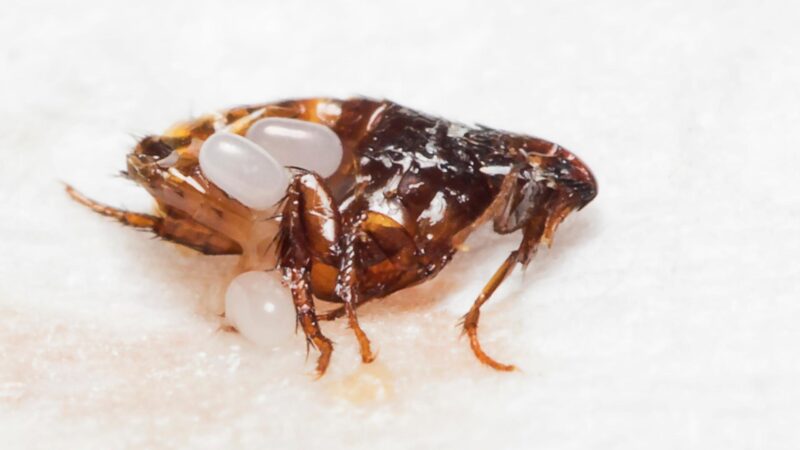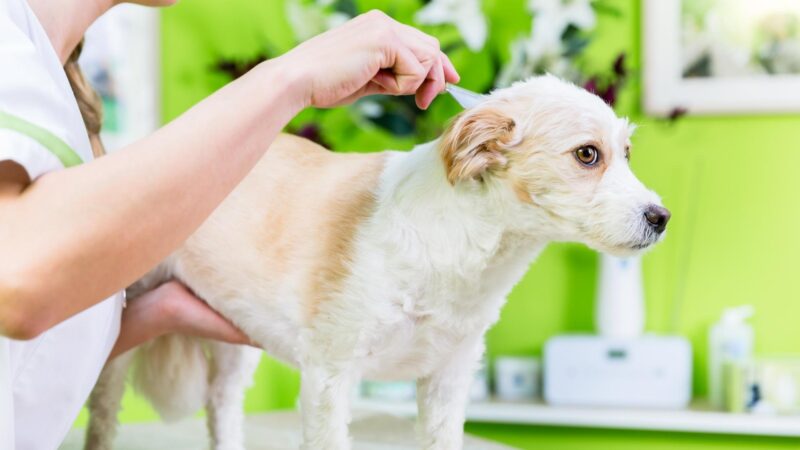Flea larvae are immature fleas, and they don’t suck the blood of pets and humans. They are harmless and don’t pose a health risk. But once ignored, they will turn into adults that will soon produce eggs.
Hence, another batch of flea larvae will emerge. So, don’t focus on adult fleas alone but their eggs and young as well.
How can you identify flea larvae? Flea larvae are very different from adult ones. They look like worms that are almost invisible to the human eye and are a bit difficult to identify. But after a closer look, you will notice that most of them are white while some of them are dark red. Flea larvae are also covered with few hairs.
Flea larvae usually make up around one-third of the flea population in houses. Depending on the weather and food availability, they can develop into mature larvae within 5 to 11 days.
Flea eggs may hatch after 2 days to 1 week. If you want to know everything about flea larvae and how to control them, this guide is for you.
Table of Contents
What Does Flea Larvae Look Like?
Flea larvae are worm-like larvae that are about 1/16 inch (1.57 mm.) long when newly hatched. After passing through three larval stages and becoming mature, they will be about 1/4 inches (6.35 mm.) long.
Flea larvae have a brown head but have no eyes and legs. But since they are very small, you may not notice them.
In some cases, flea larvae may appear black, but they are red-brown. This indicates that they have been feeding on flea dirt (adult flea excrement). During the entire larval stage, their mouthparts are not yet fully developed for piercing animal skin and sucking blood. Flea larvae also shred their skin.
Do Flea Larvae Look Like Maggots?
Flea larvae look like maggots (fly larvae) since both of them are legless, eyeless, and resemble worms. They also have the same translucent creamy white bodies, but maggots are somehow longer than them.
However, it is quite difficult to notice their difference unless you place them both under a microscope.
Do Flea Larvae Move?
Despite being legless, flea larvae can still move and crawl using the backward-pointing bristles on their bodies. Younger flea larvae move slower than the older ones, but they can also crawl away from the areas where they are hatched. Mature flea larvae also spin white, silky thread-like cocoons where they pupate.
How Do Flea Eggs Look?

Flea eggs are oval, white, or translucent, and are about 1/50 inches (0.5 mm) long, and therefore are almost microscopic. They lay eggs on the fur of their animal host.
But because eggs are dry and smooth, they usually fall on carpets, rugs, and other areas where an infested pet stays a lot and scratches its skin.
Do Flea Eggs Look Like Dandruff?

Flea eggs don’t look like dandruff except that they are both white. Unlike flea eggs, dandruff is dried skin and looks like flat flakes. While inspecting your pets, you will also notice that dandruff tends to be sticky or remain on the fur and is a bit difficult to remove. On the contrary, flea eggs will be falling naturally.
Where Do Flea Larvae Hide?

Flea larvae hide in a wide variety of places, especially in pet beds, floor cracks, furniture, and under carpets and rugs. Aside from the favorite places of pets, baby fleas also like dark, moist areas where they can find adult flea poop, pet food particles, and organic debris to feed on. Some flea larvae also hide in pets.
Can Flea Larvae Get On My Bed?
Flea larvae can also get into your bed and mattress. Although rare, this can happen if your pets are infested with fleas, and you allow them to rest and sleep on your bed.
Aside from moisture, they also survive well in warm, humid environments. This includes your bed, especially if the food source is abundant.
Can Flea Larvae Live on Humans?
Flea larvae cannot live on humans simply because they cannot find food in them. These worm-like larvae are not yet capable of biting people and pets.
Since they also cannot jump as adult fleas do, flea larvae living on human skin or hair may die sooner or get killed. But most likely, they will fall on the floor.
Can Flea Larvae Live on Cats and Dogs?
Flea larvae cannot live on cats and dogs unless these animals are heavily infested with adult fleas, and you don’t treat them. Again, these baby fleas mainly feed on the feces of their adults, but they don’t suck blood.
Flea larvae rarely get stuck on the skin, making pets easier to scratch them down to carpets and bedding.
Can Flea Larvae Live on Clothes?
Flea larvae cannot live on clothes unless you allow your infested pets to rest or sleep on your dirty laundry for a long time. If you have not been washing your clothes regularly, your pets may play inside your laundry basket.
On the other hand, clean and newly washed clothes in your cabinet are free from flea larvae.
Can Flea Larvae Survive Without Flea Dirt?
Flea larvae cannot survive without flea dirt since it is their main diet. Without it, they also cannot transform into pupae and may die within a week.
They may also eat other organic matter such as dead skin and tiny food particles. However, these food sources lack the nutritional requirements that help them survive and grow.
Why Do I See Flea Dirt But No Fleas?

It is very much possible that you may see flea dirt, but you cannot find any fleas, especially in hairy pets. This is because cats and dogs may have eaten the fleas while they are trying to remove them from their fur.
Fleas are also excellent jumpers, and they can easily jump from your pet to the pet bed or another host.
Note also that the huge presence of flea dirt is a clear sign that flea larvae have been present. If you find flea feces in different areas, this could also indicate that your pets are starting to get infested with fleas.
Therefore, you might want to check your pets under the carpets and other areas where your pets usually stay.
Can a Single Flea Larva Lead to an Infestation?

A single flea larva is very unlikely to cause an infestation, especially if you find it in a clean area or away from your pets. Seeing a random larva may mean nothing unless your dogs or cats are scratching excessively.
Since flea larvae depend on adult fleas for their food, the flea larva will soon die without them.
On the other hand, that single flea larva could have been lost while searching for a place to hide. To make sure it is alone, search the favorite spots of your pets, including the outdoors.
Flea larvae, as well as pupae, can also develop into adults in wet, shaded soil underneath shrubs and concrete walks with gaps full of soil.
What Kills Flea Eggs Naturally?
Getting rid of flea eggs can be very tricky not only because they are tiny and white; they could also be almost anywhere inside your house. The first step in finding them is to know where your pets love to stay.
If you want to avoid using insecticides in your home, here are some natural ways to kill flea eggs:
1. Vacuum thoroughly
Since flea eggs are not sticky, you can easily kill them using a vacuum cleaner. Vacuum your carpets, couches, upholstered furniture, pet bedding, floor, and other surfaces where your pets stay a lot. Vacuum thoroughly, at least once a week. A study suggested that vacuum kills adult fleas, flea larvae, and eggs.
2. Wash pet bedding with hot water
Fleas of all stages die once exposed to temperatures higher than 95°F (35°C). Wash pet bedding and blankets with hot water and pet-safe laundry detergent such as Natural Pet ECOS Pet Laundry Detergent. Make sure that their material can tolerate hot water. Don’t wash them together with your clothes.
3. Bathe your pets regularly
Flea eggs are unlikely to accumulate on your pet’s skin and fur, but they may still be there for a while. Bathing your pets regularly does not only kill flea eggs but also adult fleas. For your dogs, use a non-toxic dog shampoo with natural oils such as Vet’s Best Flea and Tick Advanced Strength Dog Shampoo.
4. Comb your pets
Aside from giving your pets a good bath, comb their fur with a flea comb with fine teeth, such as Hartz Groomer’s Best Flea Comb for Dogs and Cats. Take your time in combing the hairiest parts, including the face, neck, and tail. You might also want to dip the comb in an alcohol solution, but don’t pour it on your pets.
5. Use insect growth regulators (IGRs)
Insect growth regulators don’t kill adult fleas but prevent them from reproducing. They also disrupt the normal development of flea eggs or will kill them. IGRs are available in spot-on or sprays. Products such as Control Solutions Insect Growth Regulator are ideal for indoor and outdoor applications against flea eggs.
Safety Reminder:
If you will use insecticides, be careful when choosing products. Permethrin is safe for your dog but is very toxic to cats.
This is also why you should not use dog treatments for cats and vice versa. Always consult a veterinarian before buying.
Summary
Flea larvae may enter your home, too, even if you don’t have pets. This is because rats, mice, raccoons, and skunks can also have fleas.
To help avoid a potential flea infestation, you should also check your attics and get rid of any unwanted mammal you can find. Proper sanitation outdoors can also help a lot.